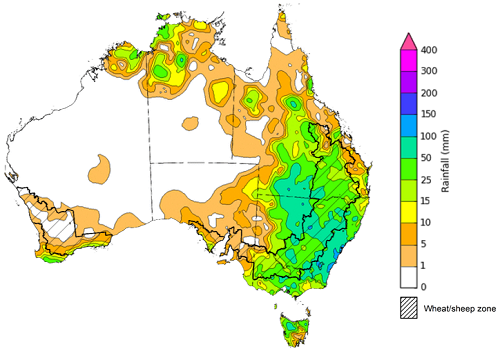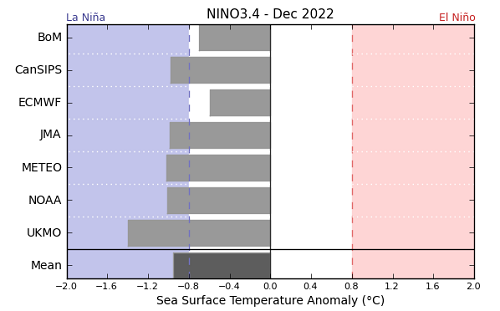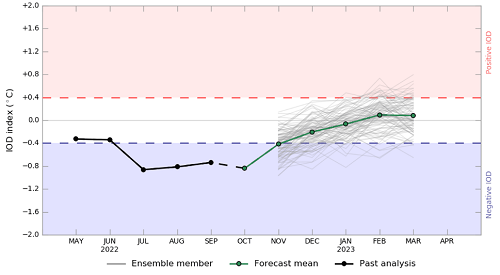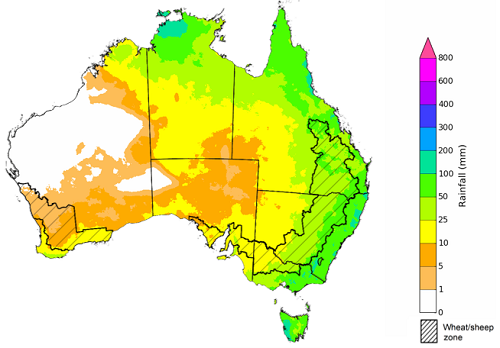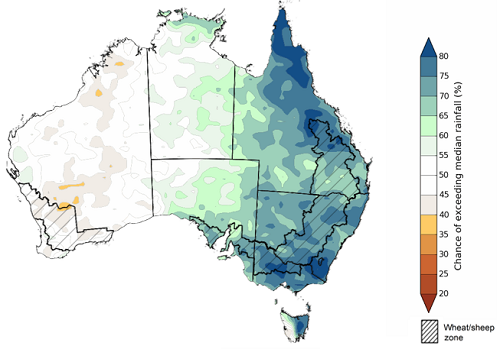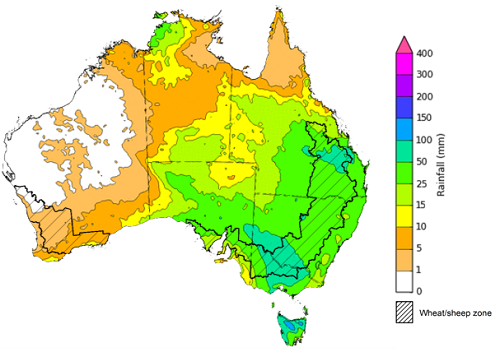Key issues
- For the week ending 12 October 2022, low-pressure systems and troughs drew down moist, tropical air, resulting in rainfall across eastern and northern Australia. Weekly rainfall totals exceeding 50 millimetres were observed across large areas of New South Wales, southern Queensland, isolated parts of Victoria and north-western Tasmania. High-pressure systems over western parts of the country resulted in clear, dry conditions in most areas.
- A return of moderate to heavy rainfall across New South Wales and Queensland cropping regions has resulted in localised flooding along low-lying areas. The risk of damage due to disease pressure and waterlogging will be exacerbated by the recent rainfall. Light to moderate rainfall across Central Queensland may have interrupted the harvesting of winter crops and the sowing of long-season summer crops in some areas. Yield prospects for winter crops across South Australia and Western Australia are very favourable as the season inches closer to harvest.
- Atmospheric and oceanic indicators underpin the recent establishment of a third consecutive La Niña event in the tropical Pacific Ocean. A negative Indian Ocean Dipole (IOD) event continues in the tropical Indian Ocean, the Southern Annular Mode (SAM) is currently positive and expected to remain positive throughout spring, and a Madden-Julian Oscillation (MJO) pulse is expected to develop over the Maritime Continent in the coming days. All climate drivers are associated with above average rainfall for eastern Australia.
- The outlook for November 2022 to January 2023 suggests there is a 75% chance of rainfall totals between 50 and 200 millimetres across Victoria, most of New South Wales, Queensland and the Northern Territory, south-eastern parts of South Australia, the north of Western Australia, and Tasmania. Through late spring and early summer, winter crop grain quality, crop abandonment and the inability to plant summer crops are major risk factors for excessive moisture.
- Over the 8-days to 20 October 2022, low-pressure systems, frontal systems, and troughs are forecast to result in showers and storms across much of the eastern two-thirds of Australia. Heavy rainfall in parts of northern Queensland over the coming week will delay the harvest of winter crops and the sowing of long-season summer crops. Significant rainfall across remaining cropping regions of south-eastern Australia will contribute to ongoing issues of waterlogging across low-lying areas.
- Water storage in the Murray–Darling Basin (MDB) decreased by 196 gigalitres (GL) between 4 October 2022 and 11 October 2022. The current volume of water held in storage is 23,948 GL, which represents 95% of total capacity. This is 9% or 1,944 GL more than at the same time last year.
- Allocation prices in the Victorian Murray below the Barmah Choke decreased from $51 per ML on 30 September to $38 per ML on 7 October 2022. Prices are lower in the Murrumbidgee and regions above the Barmah choke due to the binding of the Murrumbidgee export limit and the Barmah choke trade constraint.
Climate
For the week ending 12 October 2022, low-pressure systems and troughs drew down moist, tropical air, resulting in rainfall across eastern and northern Australia. Weekly rainfall totals exceeding 50 millimetres were observed across large areas of New South Wales, southern Queensland, isolated parts of Victoria and north-western Tasmania. High-pressure systems over western parts of the country resulted in clear, dry conditions in most areas.
In Australian cropping regions, rainfall totals of between 10 and 50 millimetres were recorded across southern and northern New South Wales, much of Queensland and Victoria, as well as isolated parts of South Australia and Western Australia. Falls in excess of 50 millimetres were recorded across central New South Wales and parts of southern New South Wales and southern Queensland. Little to no rainfall was recorded in remaining cropping regions of South Australia and Western Australia for the week ending 12 October 2022.
A return of moderate to heavy rainfall across New South Wales and Queensland cropping regions has resulted in localised flooding along low-lying areas. Flood warnings have been issued for the Barwon, Bogan, Bokhara, Castlereagh, Culgoa, Darling, Edward, Gwydir, Lachlan, Macquarie, Mirrool Creek, Murray, Murrumbidgee, Namoi, Paroo and Warrego Rivers. While yield prospects remain strong for crops not affected by flooding, the risk of damage due to disease pressure and waterlogging will be exacerbated by the recent rainfall. Growers in southern Queensland and New South Wales will be hoping for dry weather to allow crops to mature and field access for harvesting.
Light to moderate rainfall across Central Queensland may have interrupted the harvesting of winter crops and the sowing of long-season summer crops in some areas. Yield prospects for winter crops across South Australia and Western Australia are very favourable as the season inches closer to harvest. Well-timed rainfall throughout the season and no significant frost events to-date have boosted crop yields. Wet conditions across eastern Australia will delay the harvesting of winter crops across most regions, as well as the planting of summer crops.
Rainfall for the week ending 12 October 2022
Note: The rainfall analyses and associated maps utilise data contained in the Bureau of Meteorology climate database, the Australian Data Archive for Meteorology (ADAM). The analyses are initially produced automatically from real-time data with limited quality control. They are intended to provide a general overview of rainfall across Australia as quickly as possible after the observations are received. For further information go to http://www.bom.gov.au/climate/rainfall/
Throughout Australia’s late spring/early summer period the climate drivers with the largest potential impact on Australia’s climate patterns are the El Niño–Southern Oscillation (ENSO), the Indian Ocean Dipole (IOD), the Southern Annular Mode (SAM) and the Madden-Julian Oscillation (MJO). These climate drivers are likely to influence pasture growth across southern Australia, grain quality prospects and harvest conditions for winter crops, as well as the planting and establishment of summer crops across northern cropping regions.
Atmospheric and oceanic indicators underpin the recent establishment of a third consecutive La Niña event in the tropical Pacific Ocean. Cool sea surface temperature (SST) anomalies have strengthened in the central and eastern equatorial Pacific Ocean in recent weeks, while warmer temperatures persist across the Maritime Continent and to the north-east of Australia. Trade winds have been stronger than average in the western Pacific and cloudiness has also remained below average around the Date Line, which reflect the ongoing La Niña event.
A negative IOD event continues in the tropical Indian Ocean, with above average SSTs continuing in the east and below average SSTs observed in the west of the basin. The temperature gradient established across the tropical Indian Ocean reflects the ongoing negative IOD event.
The SAM is currently positive and expected to remain positive throughout spring. The MJO has remained weak throughout September and early October. However, an MJO pulse is expected to develop over the Maritime Continent in the coming days. Given current and expected conditions, the La Niña event, the negative IOD event, the positive SAM and an active MJO are all likely to influence rainfall across Australia over the coming weeks.
Difference from average sea surface temperature observations 3 October to 9 October 2022
International climate model outlooks for the NINO 3.4 region in December 2022
Issued: 12/10/2021
The La Niña event currently underway in the Pacific Ocean is expected to persist until the end of 2022 but rapidly decay in early 2023. Five of the seven international models surveyed predict the La Niña event to remain active in December, but all models expect the La Niña event to dissipate by February 2023. For the period ending 10 October, the 30-day Southern Oscillation Index (SOI) value was 19.7 and the 90-day value for the period ending 9 October was 13.4, both of which are above the La Niña threshold of +7. La Niña events are associated with above average rainfall across eastern and northern Australia through spring and summer.
30-day Southern Oscillation Index (SOI) values ending 10 October 2021
A negative IOD event persists in the Indian Ocean, with values exceeding the negative IOD threshold (−0.4 °C) since mid-June. Below average sea surface temperatures in western parts of the Indian Ocean, near the Horn of Africa, and warmer than average temperatures to the north-west of Australia tends to result in above average rainfall across southern Australia and the far north throughout spring. It is also associated with the early onset of northern Australia rainfall. As at 9 October 2022, the Indian Ocean Dipole (IOD) weekly value was -0.57°C. All international climate models surveyed by the Bureau of Meteorology predict the negative IOD event to persist throughout spring. However, the negative IOD event is expected to decline rapidly through the remainder of spring, returning to neutral by early summer.
Monthly sea surface temperature anomalies for IOD region
The Southern Annular Mode (SAM) is currently positive and is expected to remain positive throughout spring and early summer. The SAM refers to the north-south shift of the band of rain-bearing westerly winds and weather systems in the Southern Ocean compared to the usual position. A positive SAM in spring is associated with increased rainfall for parts of eastern New South Wales and Victoria as well as southern Queensland. It is also associated with decreased rainfall for parts of south-western and south-eastern Australia.
Southern Annular Mode (SAM) daily index
As at 11 October 2022 the Madden–Julian Oscillation (MJO) was forecast to strengthen over the Maritime Continent and maintain strength as it moves into the western Pacific. The MJO is a pulse of cloud and rainfall that moves eastward along the equator. An active MJO in the Pacific at this time of year increases the chance of above average rainfall over the eastern half of Australia.
Madden–Julian Oscillation (MJO) daily index
These climate outlooks are generated by ACCESS–S (Australian Community Climate Earth-System Simulator–Seasonal). ACCESS–S is the Bureau of Meteorology's dynamic (physics-based) weather and climate model used for monthly, seasonal and longer-lead climate outlooks. For further information, go to http://www.bom.gov.au/climate/ahead/about/
The Bureau of Meteorology’s latest rainfall outlook indicates wetter than average conditions are expected across parts of Australia during November. The ACCESS-S climate model suggests there is close to a 60% chance of exceeding median rainfall for parts of eastern and northern Australia, with below median rainfall likely for northern and central parts of Western Australia.
The outlook for November 2022 indicates that there is a 75% chance of rainfall totals between 10 and 50 millimetres across much of New South Wales, Queensland, Victoria, parts of southern and northern South Australia, the south-west and north-east of Western Australia, Tasmania, as well as much of the Northern Territory. Rainfall totals in excess of 100 millimetres are expected across isolated areas of alpine New South Wales and Victoria, north-eastern New South Wales and Queensland, the north of the Northern Territory, as well as western Tasmania.
Across cropping regions there is a 75% chance of rainfall totals of between 25 and 100 millimetres across much of New South Wales, Queensland, south-eastern Victoria and isolated parts of South Australia. There is a 75% chance of rainfall between 10 and 25 millimetres for remaining parts of New South Wales, Victoria and South Australia, as well as southern cropping regions of Western Australia. These falls are likely to be sufficient to support the current yield potential of winter crops, average or better pasture growth potential, and the establishment and growth of summer crops given average to above average soil moisture level across most growing regions.
Rainfall totals that have a 75% chance of occurring November 2022
Issued: 6/10/2022
The rainfall outlook for November 2022 to January 2023 suggests there is a greater than 65% chance of exceeding median rainfall across Victoria, most of New South Wales and Queensland, the south-east of South Australia, the north of the Northern Territory and eastern Tasmania. For remaining regions of Australia, there is no strong tendency towards above or below median rainfall, except for parts of north-eastern and south-western Western Australia where below median rainfall is likely between November to January (Bureau of Meteorology ‘National Climate Outlook’, 6 October 2022).
Bureau of Meteorology rainfall outlooks for November to January have greater than 55% past accuracy across most of Australia. Outlook accuracy is greater than 65% across most of New South Wales and Victoria, as well as parts of Queensland, South Australia and the Northern Territory. Past accuracy is low (less than 50%) for large areas of central Australia.
Chance of exceeding the median rainfall November 2022 to January 2023
Issued: 6/10/2022
The outlook for November 2022 to January 2023 suggests there is a 75% chance of rainfall totals between 50 and 200 millimetres across Victoria, most of New South Wales, Queensland and the Northern Territory, south-eastern parts of South Australia, the north of Western Australia, and Tasmania. Rainfall totals in excess of 200 millimetres are forecast for alpine areas in New South Wales and Victoria, as well as eastern New South Wales and Victoria, parts of eastern and northern Queensland, the far north of Western Australia and the Northern Territory, and western Tasmania.
Across cropping regions, there is a 75% chance of receiving between 50 and 100 millimetres across south-western New South Wales, Victoria, much of South Australia and south-eastern parts of Western Australia. Totals of between 100 and 200 millimetres are expected across much of New South Wales and southern Queensland, and eastern Victoria. Higher rainfall totals of between 200 and 300 millimetres are expected across parts of north-eastern New South Wales and central and northern Queensland.
Through late spring and early summer, winter crop grain quality, crop abandonment and the inability to plant summer crops are major risk factors associated with excessive moisture. Average rainfall over the coming months in southern New South Wales, Victoria and South Australian cropping regions, and below average rainfall in Western Australia is likely to allow the harvesting of winter crop to progress with minimal interruption. In central and northern New South Wales and southern Queensland, winter cropping has already been heavily impacted by excessive moisture. Above average rainfall through late spring increases the risk of waterlogging, negatively impacting crop development. As crops mature, a continuation of wet conditions may cause quality downgrades and delay harvesting. Moreover, the wet conditions are likely to interrupt planting of summer crops, which is expected to begin over the coming weeks and continue through to late spring.
Rainfall totals that have a 75% chance of occurring November 2022 to January 2023
Issued: 6/10/2022
The temperature outlook for November 2022 to January 2023 indicates that maximum temperatures across most of Australia are likely to be close to the 1990-2012 average (the difference in the range of - 1°C to +1°C), with slightly lower than average maximum temperatures across eastern New South Wales and south-eastern Queensland. Minimum temperatures are expected to be slightly above average for isolated areas of the northern and south-eastern Australia, and close to average for the rest of Australia (Bureau of Meteorology ‘National Climate Outlook’, 6 October 2022).
Predicted maximum temperature anomaly for November 2022 to January 2023
Predicted minimum temperature anomaly for November 2022 to January 2023
Over the 8-days to 20 October 2022, low-pressure systems, frontal systems, and troughs are forecast to result in showers and storms across much of the eastern two-thirds of Australia. High-pressure systems will provide clear, dry conditions across remaining parts of the country.
In Australian cropping regions, rainfall totals of between 15 and 50 millimetres are expected across New South Wales, Victoria, South Australia, and Queensland. Rainfall in excess of the of the monthly median for October are forecast for large areas of southern New South Wales, eastern Victoria and parts of northern Queensland. Little to no rainfall is forecast for remaining cropping regions in Western Australia during the next 8-days.
Heavy rainfall in parts of northern Queensland over the coming week will delay the harvest of winter crops and the sowing of long-season summer crops. Significant rainfall across remaining cropping regions of south-eastern Australia will contribute to ongoing issues of waterlogging across low-lying areas. These wet conditions are expected to prolong inundation of crops, negatively impacting yield potentials, as well as restricting the ability to access fields for early harvest activities. Yield potentials remain above average across cropping regions, but rainfall over the coming weeks is unlikely to improve them further.
The biggest threat to yield potentials across eastern and southern cropping regions remain waterlogging as winter crops begin to ripen. The continued influence of a negative Indian Ocean Dipole and the establishment of a La Niña event in the Pacific Ocean suggests a continuation of wet conditions over the coming months for eastern Australia. A likely consequence will be delays in harvesting winter crops and planting summer crops, as well as increased crop damage, downgraded grain quality and potential crop abandonment.
Total forecast rainfall (mm) for the period 13 October to 20 October 2022
Note: This rainfall forecast is produced from computer models. As the model outputs are not altered by weather forecasters, it is important to check local forecasts and warnings issued by the Bureau of Meteorology.
Water
Water storages, water markets and water allocations - current week
The Tableau dashboard may not meet accessibility requirements. For information about the contents of these dashboards contact ABARES.
Commodities
Information on weekly price changes in agricultural commodities is now available at the Weekly commodity price update.

